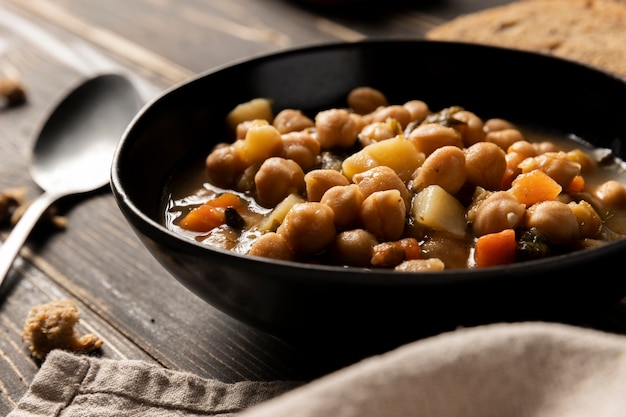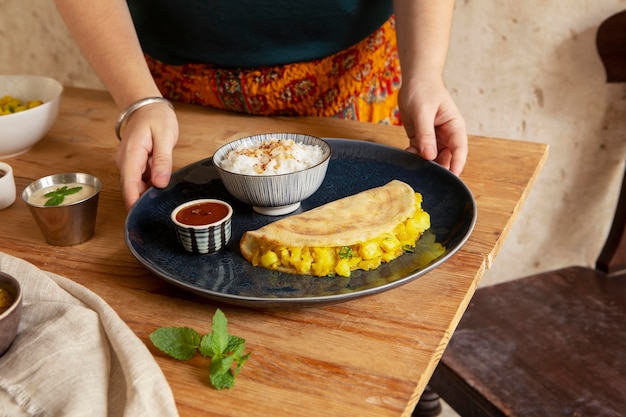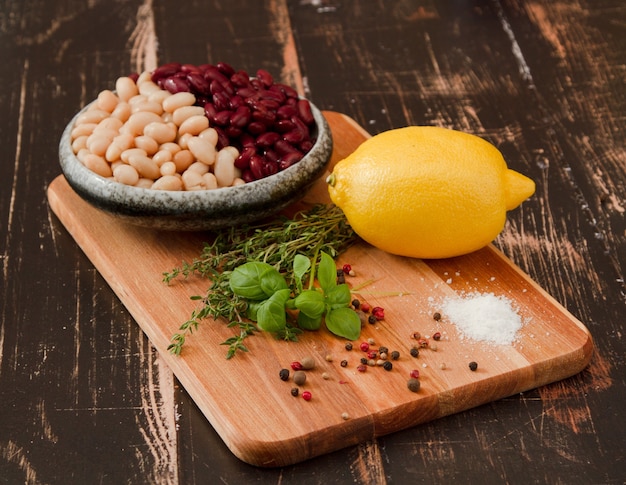Let's talk lima beans. I'll admit it, they can be a real puzzle to cook. Get them wrong and you're left with either tough, unyielding little nuggets or mushy, flavorless blobs. Trust me, I've been there – I've had my share of lima bean disasters. But fear not, I've finally cracked the code, and I'm sharing my hard-earned wisdom to help you achieve perfect, tender lima beans every time.
(Part 1) The Lima Bean Dilemma: A Tale of Two Textures

Let's face it, lima beans aren't the most glamorous of legumes. They're kind of like the wallflower at the bean party – a little shy, a little unassuming. But don't let their looks fool you. They're packed with nutrients, and when cooked properly, they can be absolutely delicious. The challenge lies in achieving that perfect texture. Lima beans have two distinct personalities, and neither one is particularly appealing:
1. The Hard, Unyielding Beast:
If you've ever encountered a hard, unyielding lima bean, you know exactly what I'm talking about. These little guys are like tiny marbles, refusing to give in to even the most determined chef. They're tough, chewy, and frankly, a bit of a nightmare to eat. They're the culinary equivalent of a bad date - you just want to get it over with.
2. The Mushy, Disappointing Mess:
On the opposite end of the spectrum, we have the dreaded mushy lima bean. Overcooked, soupy, and lacking any semblance of texture, this is a culinary disaster waiting to happen. They're like a sad, soggy puddle of what could have been a delicious legume. You're left feeling disappointed and wondering what went wrong.
(Part 2) Understanding the Basics of Lima Bean Cooking

So, how do we avoid these culinary calamities and achieve that sweet spot of tender, flavorful lima beans? It all boils down to understanding the basics of lima bean cooking. It's like mastering any other culinary skill – it takes a bit of knowledge, practice, and maybe a little bit of patience.
1. The Importance of Soaking:
The key to success lies in a good old-fashioned soak. Just like any other legume, lima beans need to be hydrated before they can soften up. Soaking helps rehydrate the beans, making them more pliable and reducing cooking time. Think of it as giving those beans a good drink before they're ready for the main event. And just like with humans, a good soak can prevent some unwanted side effects, like those pesky gas bubbles that sometimes come with bean consumption.
2. The Power of the Right Method:
There are two main ways to cook lima beans: on the stovetop and in the pressure cooker. Each method has its pros and cons, and the best choice depends on your preferences and how much time you have to spare.
(Part 3) The Stovetop Method: A Classic Approach

The stovetop method is the classic way to cook lima beans. It's simple, reliable, and doesn't require any fancy equipment. It's the tried-and-true method, passed down through generations of cooks. Here's how it works:
1. The Soaking Ritual:
Start by giving those lima beans a good soak. Rinse them thoroughly in a colander, then transfer them to a large bowl. Cover them with plenty of fresh water, ensuring the water level is at least two inches above the beans. Let them soak overnight (at least 8 hours), or even longer if you have the time. The longer the soak, the more tender the beans will be. Think of it as giving those beans a spa treatment – they'll be all the better for it.
2. The Stovetop Saga:
The next morning, drain the soaking water and rinse the beans again. Transfer them to a large pot with fresh water. Add a generous pinch of salt, a bay leaf, and a few peppercorns for flavor. Bring the water to a boil, then reduce the heat to a gentle simmer. Cover the pot and cook for about 45-60 minutes, or until the beans are tender. You can check for doneness by gently pressing a bean with the back of a spoon. It should be soft and easily yield to pressure. If it's still hard, give it a few more minutes.
3. The Timing Tangle:
The exact cooking time for lima beans can vary depending on their freshness and size. You might need to adjust the cooking time accordingly. If you're unsure, it's always better to err on the side of caution and check for doneness a few minutes early. You can always cook them a bit longer if needed, but once they're overcooked, there's no turning back.
(Part 4) The Pressure Cooker: A Time-Saving Solution
Now, if you're pressed for time or simply prefer the convenience of a pressure cooker, fear not! The pressure cooker is a great option for cooking lima beans quickly and efficiently. It's like magic – you can have perfectly cooked beans in a fraction of the time. Just remember, you need to adjust the soaking and cooking times.
1. The Accelerated Soak:
For the pressure cooker method, you can get away with a shorter soak. Simply rinse the beans and cover them with water for about 2 hours. This will give them enough time to hydrate and soften up.
2. The Pressure Cooker Plunge:
After soaking, drain the beans and transfer them to your pressure cooker. Add fresh water, a pinch of salt, and any other desired seasonings. Secure the lid and bring the pressure cooker to high pressure. Once the pressure cooker reaches high pressure, reduce the heat and cook for about 15-20 minutes.
3. The Quick Release:
Once the cooking time is up, carefully release the pressure using the quick-release method. Open the lid and check the beans for tenderness. If they need more cooking, you can add a few more minutes of pressure cooking.
(Part 5) Tips and Tricks for Perfect Lima Beans
Now, let's delve into some handy tips and tricks to ensure your lima beans turn out absolutely perfect. These are the secrets that will make all the difference between a good bean dish and a truly exceptional one.
1. The Starch Solution:
Lima beans, like many other legumes, release starch during cooking. This starch can make the water cloudy and sometimes even create a slightly gummy texture. To combat this, you can add a teaspoon of baking soda to the cooking water. The baking soda helps break down the starch, resulting in clearer cooking water and a smoother texture.
2. The Acid Advantage:
Adding a splash of acid, such as lemon juice or vinegar, to the cooking water can also help tenderize the beans. The acid helps break down the tough outer layer of the beans, making them more easily digestible. Plus, it adds a subtle flavor boost. It's like giving those beans a little extra pep in their step.
3. The Flavor Boost:
Don't be afraid to experiment with different seasonings. A simple combination of salt, pepper, and a bay leaf works well, but you can also get creative with herbs like thyme, rosemary, or oregano. For a more savory flavor, try adding a pinch of garlic powder or onion powder. You can even add a touch of sweetness with a sprinkle of brown sugar.
(Part 6) Delicious Ways to Enjoy Lima Beans
Alright, now that you've mastered the art of cooking lima beans, let's talk about the fun part: eating them! There are endless possibilities when it comes to enjoying these delicious legumes.
1. The Classic side dish:
Lima beans are a versatile side dish that complements a wide range of meals. They're a classic pairing with roast chicken, pork chops, or fish. Simply toss them with a drizzle of olive oil, a sprinkle of salt and pepper, and some chopped fresh herbs. You can even add a little bit of lemon zest for a touch of brightness.
2. The Soup Sensation:
Lima beans are also a fantastic addition to soups and stews. Their creamy texture and mild flavor make them a perfect base for hearty winter dishes. Try adding them to a classic minestrone soup or a chunky vegetable soup. They also pair well with creamy soups, like potato leek soup or butternut squash soup.
3. The Salad Star:
Don't be afraid to get creative and add lima beans to salads. They add a unique texture and nutritional boost. Try them in a simple green salad with fresh herbs and a light vinaigrette, or in a more complex salad with roasted vegetables and grilled chicken. They also work well in salads with a Mediterranean twist, like a Greek salad or a quinoa salad.
4. The Savory Snack:
For a healthy and satisfying snack, try tossing cooked lima beans with a bit of olive oil, salt, and pepper. You can also add a sprinkle of herbs or spices for extra flavor. They make a great alternative to chips and dip, and they're a great source of protein and fiber.
5. The Beyond-the-Ordinary:
Lima beans can also be used in a variety of other dishes, such as dips, spreads, and even desserts. Try them in a black bean dip, a bean salad, or even a lima bean ice cream.
(Part 7) The Lima Bean Dilemma: A Guide to Freezing and Storing
We've talked about cooking and enjoying lima beans, but what about those leftover beans? No need to worry – we've got you covered. Let's explore the best ways to store and freeze those delightful little legumes.
1. The Freezing Fix:
Freezing cooked lima beans is a great way to preserve them for later use. Simply let the beans cool completely, then transfer them to a freezer-safe container or bag. Freeze them for up to 3 months. You can even freeze them in individual portions to make it easier to use them later.
2. The Storage Strategy:
If you're not freezing your lima beans, you can store them in the refrigerator for up to 4 days. Make sure to store them in an airtight container filled with the cooking liquid. This will help keep them moist and flavorful.
(Part 8) FAQs: Unraveling the Lima Bean Mystery
Alright, now for the burning questions. You know, the ones that keep you up at night. Let's tackle those lima bean mysteries head-on.
1. Are All Lima Beans Created Equal?
Not necessarily. You can find two main types of lima beans: baby limas and large limas. Baby limas are smaller, more delicate, and have a sweeter flavor. They're often used in salads and side dishes. Large limas, on the other hand, are bigger and have a slightly starchy texture. They're often used in soups and stews.
2. What If My Lima Beans Are Still Hard?
If your lima beans are still hard after cooking, don't despair! Just add a bit more water to the pot and cook them for another 15-20 minutes. If you're using a pressure cooker, you can add a few more minutes of pressure cooking.
3. Can I Substitute Other Beans for Lima Beans?
While lima beans are unique in their flavor and texture, you can try substituting them with other white beans, like butter beans or cannellini beans. Just keep in mind that the cooking times and textures may vary.
4. Why Do Lima Beans Make Me Gassy?
Lima beans, like many other legumes, contain sugars that can be difficult to digest. These sugars can lead to gas and bloating. To reduce these effects, make sure to soak your beans thoroughly and cook them until tender. You can also try adding a teaspoon of baking soda to the cooking water to help break down the sugars. If you're still having trouble, you can try taking a digestive enzyme supplement.
5. Can I Use Canned Lima Beans?
Absolutely! Canned lima beans are a convenient and easy option. They're already cooked and ready to use, saving you time and effort. Just drain and rinse them before adding them to your recipe. Canned lima beans can be a good option for a quick and easy meal, but they often have a higher sodium content than dried lima beans.
6. What are the Nutritional Benefits of Lima Beans?
Lima beans are a good source of protein, fiber, and various vitamins and minerals, including folate, iron, and potassium. They're also low in fat and calories.
There you have it, my friends. A comprehensive guide to conquering the lima bean challenge. Remember, it's all about patience, understanding, and a little bit of culinary love. So next time you're craving a delicious and nutritious bean dish, don't shy away from those humble lima beans. With this guide in hand, you'll be whipping up delectable lima bean delights in no time.
Everyone is watching

Corn on the Cob: The Ultimate Guide to Perfectly Cooked Ears
Healthy MealsAh, corn on the cob. Just the name evokes images of sunny days, barbecues, and that sweet, juicy flavour that ...

Perfect Pork Roast Oven Cooking Time: A Guide to Delicious Results
Healthy MealsThere's something truly satisfying about a perfectly roasted pork. The aroma alone is enough to make your mout...

Ham Cooking Time: How Long to Bake, Smoke, or Boil a Delicious Ham
Healthy MealsAh, ham. It's a classic, isn't it? A real crowd-pleaser, especially around holidays. And when done right, it'...

Scallops: The Ultimate Guide to Perfect Cooking
Healthy MealsAh, scallops. Those delicate, sweet, and utterly delicious morsels of the sea. They hold a special place in my...

Spaghetti Squash: The Ultimate Guide to Cooking and Serving
Healthy MealsRemember that time you saw spaghetti squash at the supermarket, looking all bumpy and strange, and thought, "W...
